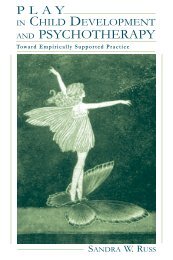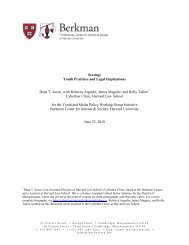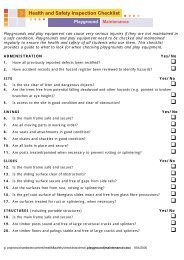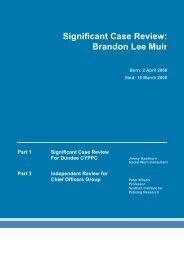Download PDF - Fair Play For Children
Download PDF - Fair Play For Children
Download PDF - Fair Play For Children
You also want an ePaper? Increase the reach of your titles
YUMPU automatically turns print PDFs into web optimized ePapers that Google loves.
Case study – Dudley <strong>Children</strong>’s Trust<br />
The Dudley <strong>Children</strong>’s Trust, based in the heart of the Black Country, has taken a lead in<br />
bringing together all statutory, voluntary, community and third sector providers in the<br />
development of its pioneering play strategy entitled Just Enjoy!<br />
Over 6,000 children and members of the public were involved in identifying the key priorities<br />
for the borough including deciding where to spend the £700,000 Big Lottery Fund <strong>Children</strong>’s<br />
<strong>Play</strong> Initiative grant. In an area of only 38 square miles, and with a population of over 75,000<br />
children and young people, school sites and playing fields form an essential part of the play<br />
provision and green space for children across the borough.<br />
Many head teachers and governors have come forward to make sure their valuable facilities<br />
are available out of school hours. This includes one primary school that worked with the local<br />
Tenants and Residents Association to apply for over £100,000 of lottery funding to open up its<br />
school playing fields and build a new community multi-purpose games area and small<br />
children’s play area on their land. The school is planning to position the fencing for the new<br />
area on the school site, so that the new facility is open all hours and available for community<br />
use at all times. <strong>For</strong> details of the Dudley programme, visit www.justenjoy.tv which also<br />
advertises the new lottery funded play activities across the borough.<br />
Physical activity, physical education and sport<br />
2.30<br />
2.31<br />
2.32<br />
2.33<br />
2.34<br />
<strong>Children</strong>’s play has a key role in instilling from an early age an awareness of, and enthusiasm for,<br />
healthy and active living, and thus is a significant contributor to reducing child obesity.<br />
Unstructured play as a form of physical activity in the early years supports the development of<br />
health and wellbeing and the subsequent benefits of this in later life.<br />
<strong>Play</strong>, physical education and sport complement each other. <strong>Play</strong> is unorganised whereas sport<br />
is organised and usually played within structured rules. <strong>Play</strong> is what children do of their own<br />
volition, often making up their own informal rules. But it is through play that children often<br />
have their first experiences of sport and develop basic sporting skills such as kicking a ball<br />
around, racing their friends, or climbing.<br />
Physical education (PE) is taught as part of compulsory education from ages five through to 16.<br />
It differs from sport, play and physical activity in that it is compulsory, has a structured,<br />
progressive programme of study, and, when taught properly, learning has to take place. In<br />
physical activity and sport, the emphasis is on the activity; in PE, the emphasis is on the child.<br />
Eighty six percent of 5–16 year olds now do at least two hours of high quality PE and sport a<br />
week. The new PE and sport strategy for young people will offer all 5–16 year olds two hours of<br />
high quality PE and sport within the school day, and all 5–19 year olds who want it will have<br />
access to up to a further three hours of sport beyond the school day, delivered by a range of<br />
school, community and club providers. This new commitment will be supported by a total<br />
investment of £766 million revenue funding between 2008 and 2011.<br />
<strong>Play</strong> can contribute to increasing the amount of physical activity, PE and school sport<br />
undertaken by children and young people by engaging them in physical activity that they<br />
enjoy. We want to see how new play arrangements can signpost children and young people<br />
<strong>Fair</strong> <strong>Play</strong>: A consultation on the play strategy<br />
21



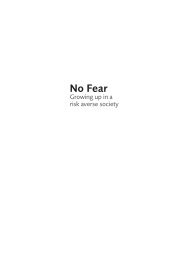
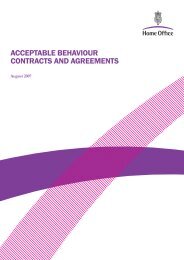
![The Childcare Act 2006 - Notes [Website] - Fair Play For Children](https://img.yumpu.com/50144819/1/184x260/the-childcare-act-2006-notes-website-fair-play-for-children.jpg?quality=85)




![Bouncy Castles [PDF] - Fair Play For Children](https://img.yumpu.com/45463572/1/184x260/bouncy-castles-pdf-fair-play-for-children.jpg?quality=85)

